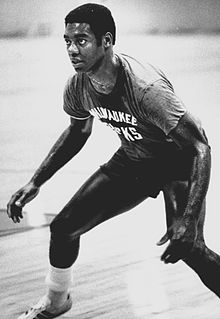Oscar Robertson
[1] Robertson played point guard and was a 12-time All-Star, 11-time member of the All-NBA Team, and one-time winner of the MVP award in 14 seasons.
When he was approximately 18 months old, his parents moved to Indianapolis, Indiana, where he grew up in the segregated housing project of Lockefield Gardens.
He learned how to shoot by using tennis balls and rags wrapped with rubber bands and tossing them into a peach basket in the back of his family's home.
When Robertson was a junior, Crispus Attucks dominated its opposition, going 31–1, and winning the 1955 state championship, the first for any all-black school in the nation.
[4] Robertson continued to excel while playing for the Cincinnati Bearcats, recording a scoring average of 33.8 points per game, the third-highest in college history.
When Robertson left college, he was the all-time leading NCAA scorer until fellow Hall-of-Fame player Pete Maravich topped him in 1970.
In those days, Southern university programs such as Kentucky, Duke, and North Carolina did not recruit black athletes, and road trips to segregated cities were especially difficult, with Robertson often sleeping in college dorms instead of hotels.
Ten of the twelve college players on the American squad later played in the NBA, including Robertson as well as future Basketball Hall-of-Famers West, Jerry Lucas, and Walt Bellamy.
He was named NBA Rookie of the Year, was elected into the All-NBA First Team—which would happen in each of Robertson's first nine seasons—and made the first of 12 consecutive All-Star Game appearances.
[1] In addition, he was named the 1961 NBA All-Star Game MVP following his 23-point, 14-assist, 9-rebound performance in a West victory; however, the Royals finished with a 33–46 record and stayed in the cellar of the Western Division.
[1] The Royals advanced to the Eastern Division Finals, but succumbed in a seven-game series against a Boston Celtics team led by Bill Russell.
[2] Robertson also won his second All-Star Game MVP award that year after scoring 26 points, grabbing 14 rebounds, and dishing off 8 assists in an East victory.
On December 18, 1964, Robertson recorded a career-high 56 points on 17-for-33 shooting from the field, to go along with 9 rebounds and 12 assists in a 111–107 win over the Los Angeles Lakers.
Despite Robertson recording averages of at least 24.7 points, 6.0 rebounds and 8.1 assists in the six following seasons,[1] the Royals were eliminated in the first round from 1965 to 1967, then missed the playoffs from 1968 to 1970.
[2] Prior to the 1970–71 season, the Royals stunned the basketball world by trading Robertson to the Bucks for Flynn Robinson and Charlie Paulk.
"[2] The relationship between Oscar and the Royals had soured to the point that Cincinnati had also approached the Lakers and Knicks about deals involving their star player; the Knicks players who were discussed in those scenarios are unknown, but Los Angeles stated publicly that the Royals asked about Jerry West and Wilt Chamberlain, with the Lakers saying they would not consider trading either star.
It was the year of the landmark Robertson v. National Basketball Ass'n, an antitrust suit filed by the NBA's Players Association against the league.
In this suit, the proposed merger between the NBA and American Basketball Association was delayed until 1976, and the college draft, as well as the free agency clauses, were reformed.
[28] After he retired as an active player, Robertson stayed involved in efforts to improve living conditions in his native Indianapolis, especially concerning fellow African-Americans.
In 1994, a nine-foot bronze statue of Robertson was erected outside the Fifth Third Arena at Shoemaker Center, the current home of Cincinnati Bearcats basketball.
He was one of five people, along with John Wooden, Bill Russell, Dean Smith, and James Naismith, selected to represent the inaugural class.
[35] The initiative sought exclusive grow rights for the group members while prohibiting all other cultivation except small amounts for personal use.
Robertson is regarded as one of the greatest players in NBA history, a triple threat who could score inside, outside and also was a stellar playmaker.
[citation needed] For his career, Robertson shot a high .485 field goal average and led the league in free-throw percentage twice—in the 1963–64 and 1967–68 seasons.
[1] Standing 6 ft 5 in (1.96 m), Robertson is recognized by the NBA as the first legitimate "big guard", paving the way for other oversized backcourt players like Los Angeles Lakers legend Magic Johnson.
[41] For the Cincinnati Royals, now relocated and named the Sacramento Kings, he scored 22,009 points and 7,731 assists, and is the all-time leader in both statistics for the combined Royals/Kings teams.
In 1998, it was renamed the Oscar Robertson Trophy in his honor, as the player that won the first two awards, because of his outstanding career and his continuing efforts to promote the game of basketball.
[45] In 2024, NBA Commissioner Adam Silver announced that the league had commissioned a statue of Robertson from sculptor Ryan Feeney to be permanently placed at Crispus Attucks High School.
[47] Regarding basketball, Robertson has stated that legendary Harlem Globetrotters players Marques Haynes and "clown prince" Goose Tatum were his idols.
On June 9, 2007, Oscar received an Honorary Doctorate of Humane Letters from the University of Cincinnati for both his philanthropic and entrepreneurial efforts.






